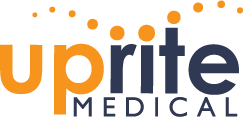Imagine living without that annoying back pain that’s always bothering you. That’s what Spinal Cord Stimulator (SCS) surgery can help you achieve. But what happens after the surgery? Let’s simplify it.
We’ll guide you through your recovery, from leaving the hospital to relaxing at home, until you’re back to your usual self but without the pain. Uprite helped lots of people through this, and trust me, the results are awesome.
But, there are important rules to follow to supercharge your spinal cord stimulator surgery recovery time and keep your new device safe and working well. Let’s check out what are those.
Jump To:
- Spinal Cord Stimulator Surgery Recovery Time
- Restrictions and Considerations After SCS Surgery
- Post-Surgery Health Guide
Spinal Cord Stimulator Surgery Recovery Time
Recovery from Spinal Cord Stimulator (SCS) surgery is generally divided into two phases. Initially, the focus is on healing from the surgery itself, with incision sites typically taking about 2 to 4 weeks to heal. During this period, patients are advised to avoid heavy lifting and strenuous activities to ensure proper healing and prevent displacement of the newly implanted device.
Following successful implantation, patients can expect to gradually return to normal activities. Most people can resume light daily activities and work within 4 to 6 weeks post-surgery, with full adjustment to the device and a return to more physically demanding tasks potentially taking up to 8 to 12 weeks.
Here’s a closer look:
Hospital Recovery
Your hospital stay post-SCS surgery is brief, usually one to two days, where your medical team monitors your pain management and ensures the incision site is healing as expected. This initial phase is critical for adjusting to your new neuromodulation system.
Home Recovery
Recovery at home after spinal cord stimulator (SCS) surgery is a crucial time for healing and adaptation. Patients are typically advised to take it easy and allow themselves a recovery period of about 3 weeks. During the first 10 days post-surgery, there’s a key opportunity for your pulse generator to be adjusted and checked, ensuring everything is healing as it should be. This is also when any discomfort or concerns should be communicated to your physician.
Expect to feel more tired than usual during your recovery. It’s normal to need extra sleep or take longer rests during the day, as your body is using a lot of energy to heal. To protect the implanted device and ensure proper healing, avoid excessive movements such as twisting, reaching overhead, or lifting heavy objects for the first 2-3 weeks. Having a support system of friends and family will be invaluable during this time, helping you to rest and recover without unnecessary stress.
Full Recovery
Achieving full recovery and resuming normal activities can take up to 12 weeks. This period includes follow-up appointments to check on the device’s function and any signs of infection, ensuring your journey back to health is on track.
Restrictions and Considerations After SCS Surgery

After SCS surgery, patients must navigate several restrictions to ensure the implant remains effective and complications are avoided. Key considerations include:
1.Physical Activity Restrictions:
- Avoid lifting objects over 5 pounds during the initial weeks post-surgery to prevent displacing the stimulator leads.
- Refrain from activities that involve significant bending, twisting, or stretching.
2.Medical Imaging Procedures:
- X-rays and CT Scans– Safe when the SCS is turned off, but always inform the technician or doctor of your implant.
- MRI Compatibility– Some SCS systems are MRI-safe under certain conditions; however, many are not. It’s vital to consult with your healthcare provider before scheduling an MRI to prevent any risk of injury.
3.Daily Life and Employment:
- Driving– Typically, driving is resumed 1-2 weeks post-surgery, with approval from your surgeon.
- Work– Return to work timelines vary based on your recovery and the nature of your job. Discuss your specific situation with your healthcare provider.
- Travel and Security:
- Airport Security– Your stimulator may trigger metal detectors. Carry an identification card provided by your physician to explain your condition. Consider turning off your device to avoid discomfort from security devices.
- Leisure Activities:
- Swimming– Allowed with a permanently implanted generator, but exposure to water should be avoided during the trial period with a temporary device. Ensure your incisions are fully healed before swimming.
- Device Management and Maintenance:
- Stay informed about your specific SCS model and its compatibility with various activities and medical procedures.
- Regular check-ups with your pain specialist are essential to monitor the condition of your implant and to make any necessary adjustments.
- Removal and Replacement:
- Should issues arise or if you’re dissatisfied with the pain relief, the device can be safely removed or replaced after consulting with your specialist.
By closely following these guidelines, you can maximize the benefits of your spinal cord stimulator, manage your pain effectively, and maintain a healthy, active lifestyle.
Post-Surgery Health Guide

For an optimal recovery and to maintain your spinal cord stimulator (SCS) effectively:
- Rest– Give your body plenty of rest to heal properly. Avoid overexerting yourself.
- Medications– Follow your medication plan strictly to control pain and prevent infections.
- Incision Care– Keep the surgical area clean and dry. Follow instructions on bathing and dressing changes.
- Support– Utilize your support network for help with daily activities and emotional support.
- Diet & Exercise– Eat a balanced diet and stay hydrated. Introduce gentle exercises as recommended by your doctor, avoiding activities that could disrupt the SCS.
- SCS Maintenance– Familiarize yourself with your SCS device operations and attend regular check-ups for device management.
- Mindfulness– Practice stress-reduction techniques like meditation to help manage pain and improve recovery.
To Wrap Up
The journey through Spinal Cord Stimulator surgery recovery is a pathway to regaining control over your life, free from the constraints of chronic pain. With the right preparation and understanding of the recovery time, restrictions, and considerations after SCS surgery, you’re well on your way to a brighter, more comfortable future.
At Uprite, we’re committed to guiding you through every step of this journey, from initial consultation to achieving a successful recovery. If you’re navigating the recovery process or considering SCS as a treatment option for chronic back pain or other medical conditions, our team is here to support you.
Explore our resources, reach out for a consultation, and let us help you with a personalized treatment plan for your spine condition. Fill out our evaluation form to get started.








